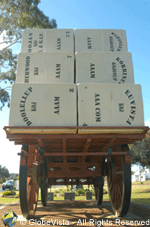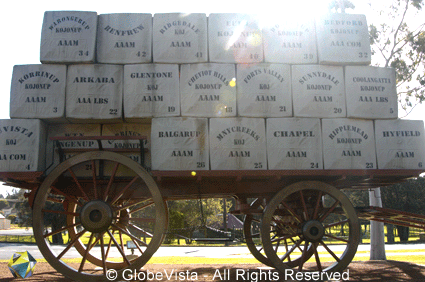Centenary of Federation Wool Wagon

Public Art : Centenary of Federation Wool Wagon
Artist: Unknown
Description : The 1.5 times wool wagon replica is constructed of steel and timber and the 42 wool bales are made from fibreglass. Each wool bale is stamped with the name of a local farm. The wool wagon sits on a stone platform.
Location : You can’t miss it, it sits right there on Albany Highway.
Unveiled : The Centenary of Federation Wool Wagon was unveiled on Australia Day, 2001 by George Church.
Funded By : The Kojonup wool wagon was a joint project by Rotary, Apex and Lions clubs. Funds were raised through fund raising events and several grant submissions including Centenary of Federation and the Lotteries Commission of WA.
Inscription :
The wool wagon replica was constructed by the service clubs of Kojonup to show the vital part that the wool industry has played in the history of the district. The foundation and development of this area has bee largely based around the sheep industry and the production of wool to satisfy local and overseas markets.
In 1849, early settlers selected tracts of land to graze flocks of sheep that were driven to the area from the Albany District. News of fertile land suitable for grazing traveled fast and many people saw Kojonup as a profitable proposition for sheep farming.
Edward John Eyre ferried 1,000 ewes and 450 lambs ashore from King George Sound , driving them along the route to the Swan River Colony. Some of these sheep were ourchased by captain Thomas Lyal Symers, who moved them to green pastures south of Kojonup (what is now “Balgarup”) by agreement with the proprieter of the Royal Hotel in Fremantle. However, poisonous shrubs caused heavy losses and the fledging enterprise seemed doomed. Symers vision resulted in the birth of the industry, though factors beyond his control forced him to withdraw and leave others to reap te benefits.
The wool industry frst boomed in the 1860’s and by 1908 there were 10,500 sheeo in the Kojonup district. In 1969, over 1 million were shorn in the Kojonup Shire.Through the years , the industry has been through booms and depressions.
Now wool is produced by selection for particular markets and wool growing is a highly technical business. Kojonup produces some of the best Merino wool in the world, with many industries feeding from the process. Shearing the sheep has progressed from the days of hand shears to finely tuned electrically-diven gear that has increased the speed of the operation enormously. Cottage industries have developed, finding innovative ways to use wool which is still one of the best quality natural fibres.
Wool wagons, such as the model here, were used by the early settlers to transport their bales to markets or to depots. Horses were harnessed to the front of the wagons and considerable skill was required to operate and manoeuvre these large vehicles. Loading the bales onto the wagons was back-breaking work and each farmer had to identify his wool clip with his own brand, which became unique to the property from which the wool was produced.
So Who’s On The Bales? :

No 1 RIVERDALE
Derek, Kath and Sue Piesse
1906 – “Farm is on a river and gully”
No 2 WATTLEDALE
K.J. Bilney and Co
1949 – “Named after native vegetation”
No 3 KORRINUP
George and Trish Church
1906 – “Home of the Plover”
No 4 EUVISTA
Alex, Judy & Cameron Cant
1953 – “Good view”
No 5 COOLANGATTA
Alan and Shirley Crook
1939 – “Pleasant view”

No 6 HYFIELD
R.D. Lester
1926 – “By the original founder of the stud”
No 7 SHERWOOD
Craig and Liz Heggaton
1990 – “Sherwood Forest in England”
No 8 DOOLELLUP
Geoff and Glenys Reinke
1900 – “Welcoming place with water”
No 9 YANNAWAH
Joe and Lou Young
1955 – “Of Aboriginal origin (NSW)”
No 10 WARRENS CREEK
Greg and Helen Marsh
1946 – “Named after creek on property”
No 11 ROCKY GLEN
The Stewart Family
1928 – “Named by previous owner”
No 12 MANDALUP
Andrew and Diana Hassell
1901 – “From Mandalup Creek”
No 13 KINGSHURST
Rob and Bay Campbell-Wilson
1951 – “Based on family name – King”
No 14 KENERRUP
Ned and Robyn Radford
1930 – “Water”
No 15 BROOME FARM
Gordon Adams and Co
1900 – “Named after native vegetation”
No 16 COOMAL PARK
John and Virginia Crabb
1980 – “Place of the possum”
No 17 ROCKY CREEK
Mick, Michael & Shelley Bilney
1924 – “Rocky creek on property”
No 18 CHEVIOT HILLS
Paul Bennecke
1960 – “Previous family farm”
No 19 GLENTONE
William Harvey and Son
1950 – “Glen -English, Tone – river”
No 20 SUNNYDALE
ROss and Jo Goodall
1898 – “Rolling hills and green valleys”
No 21 FORTS VALLEY
Arnold Bilney and Family
1910 -“Forts St. Boys School, Sydney”
No 22 ARKABA
The Tohl Family
1950 – “Land of plenty & hidden waters”
No 23 RIPPLEMEAD
Marty and Sheena House
1926 – “Family farm in South Africa”
No 24 CHAPEL
Les, June, Tim and Jo Johnston
1937 – “Family farm in Scotland”
No 25 M N Y CREEKS
Graeme and RHonda Phillips
1936 – ” A lot of creeks”
No 26 BALGARUP
John & Kristen Carrington-Jones
1841 – “Named after the river”
No 27 LAGAR DOWNS
Willy and Jan Bowers
1960 – “Named by previous owner”
No 28 ANGENUP
W.T. Norrish and Sons
1903 – “Aboriginal name”
No 29 WATERSON
Dennis, Jan & Simon Zacher
1970 – “Named by previous owner”
No 30 CARRINGTON
Will & Heather Carrington-Jones
1957 – “From home property in Tasmania
No 31 VALLEY
John and Christine Lewis
1951 – “Valley where the bush orchids grow”
No 32 BEDFORD
John and Jo Sexton
1918
No 33 KOOJAN
A.R. and M.A. Padbury
1957 – “Watering place”
NO 34 WARONGERUP
Trevor, Jenny and Dustin Fisher
1907 – “Name of the creek”
No 35 WOODVILLE
Ian and Heather Haggerty
1910 – “Suburb in Adelaide”
No 36 ANDOVER
FR (Dick) Mathwin Family Trust
1990 – “From Upwood farm”
No 37 PRATELLA – GLENLOSSIE
Reno Guidi and family
1959 – “Home town in Italy”
No 38 PINE AVENUE
Eric and Cathy Wright
1960 – “Farm avenue of pines”
No 39 DOREENUP
TIm and Anita Eyres
1913 – “Named after Doreen Wigglesworth (later Potts)”
No 40 EULO
Wyatt Fisher Holdings
1928 – “Highly recommended”
No 41 RIDGEDALE
Royce and Joyce Stapleton
1960 – “Family farm in NSW”
No 42 RENFREW
Leslie and Joan O’Halloran
1904 – “Town in Scotland”